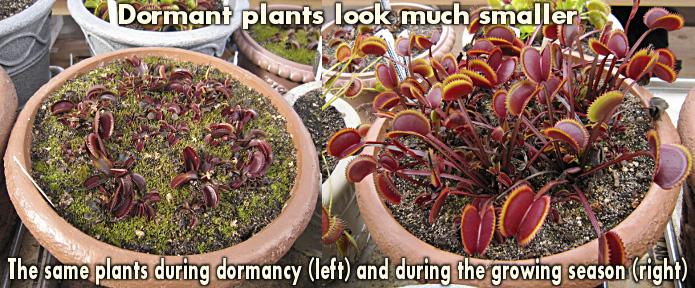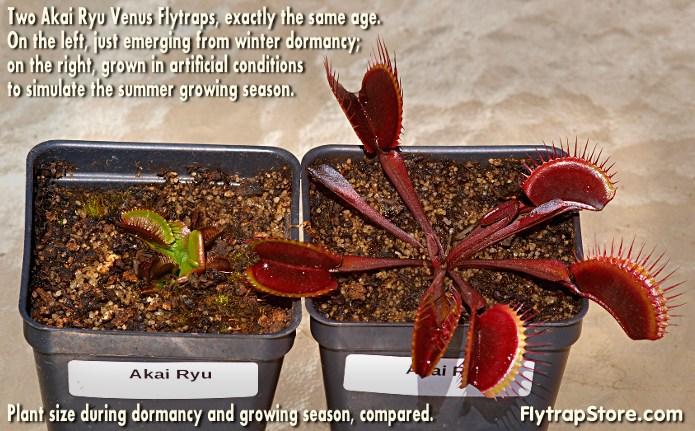Information About the Plants
Plants in Dormancy
Customers should be aware that Venus Flytraps during dormancy appear much smaller than they do during the growing season. A plant that may look small above ground may have the bulb and root development of a large, mature plant, and will grow vigorously once it emerges from dormancy. So if ordering a Venus Flytrap during dormancy (and this applies also to some other carnivorous plants such as temperate Drosera), roughly November through March, the leaf growth will be much shorter and the growing rosette much smaller.
Plants in dormancy should be kept in conditions that promote dormancy (cool to cold but not freezing, thorough but less frequent watering). They will naturally emerge from dormancy in mid to late Spring when the daylight is longer and the temperatures warmer. The photos below illustrate the size difference between plants during the growing season and during dormancy.


Plant Sizes and Maturity
This information applies only to those plants that have a size / maturity option when purchasing.
Plant sizes are based on several characteristics including age, maturity, root development and rhizome size, as well as the relative size of the particular plant to other plants of its type. For example, a mature Cupped Trap Venus Flytrap is very likely to be smaller than a even an immature Typical Venus Flytrap, because Cupped Trap is a relatively small plant regardless of its age or maturity.
The sizing information below is intended to give the customer a good general idea of what to expect from different plant sizes rather than a precise description.
Plant Sizes
Venus Flytraps
- Starter — a small or juvenile size plant, at least a year or two worth of good growing away from flowering, but well "hardened" (if from tissue culture) and acclimated, with healthy root and leaf growth.
- Young — a near flowering size or flowering size plant, not a baby nor a juvenile but instead a plant well on its way to adulthood and well "hardened" (if from tissue culture) and acclimated, with healthy root and leaf growth.
- Young Adult — a well established, adult, flowering-size plant well on its way to maturity and well "hardened" (if from tissue culture) and acclimated, with healthy root and leaf growth.
- Mature — These are mature or nearly mature, very well established, healthy and robust plants. If dormant, their leaf growth may appear smaller than one might expect, but their root systems and bulb (if a Venus Flytrap) are very well developed and they will grow vigorously and rapidly once they emerge from dormancy.
- Premium — Not often available and only in limited quantities, these are the best plants we offer, the largest in size, the most mature, and in peak physical condition. These are very robust plants with (if Venus Flytraps) exceptionally large bulbs and very extensive root growth and leaf development (although the leaves may be smaller during dormancy). Note—The "Premium" size is recommended for experienced growers because of the cost; new growers or casual hobbyists may prefer to learn with less expensive plants first.
Cephalotus and Heliamphora
Cephalotus roots are fleshy and often brittle. If buying a bareroot plant, be sure to handle it gently and plant with care.
- Young — A small Cephalotus or Heliamphora consisting of juvenile pitchers.
- Young Adult — In the case of Cephalotus, the young-adult size will have one or more adult-form pitchers although they may be small. In the case of Heliamphora, the young-adult size will be larger and more well-developed than the young size, although the pitchers while larger might still be juvenile in shape.
- Mature — An adult Cephalotus or Heliamphora with mature pitchers and extensive root system. Mature Cephalotus plants require a fairly large pot (at least 4-6 inches in both depth and diameter, and preferably 6-10 inches / 15-25 centimeters) in order to develop their characteristic extensive root system and multiple growing crowns. Heliamphora can be initially planted in smaller pots but their root systems over time become very developed and they form dense colonies, so they benefit from more space for their roots and many leaves and pisions.
Only the sizes that are currently in stock are listed as options when purchasing a plant. For example, the "premium" size may not often be listed, and sometimes "young" or "young adult" may be the only size offered at the time.
If you have any questions or suggestions, please send them to the Flytrap Store customer service team.
